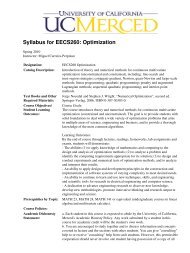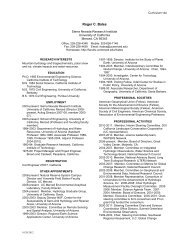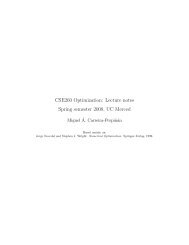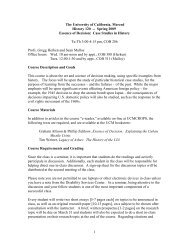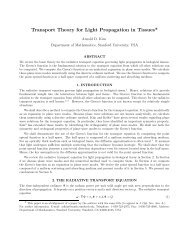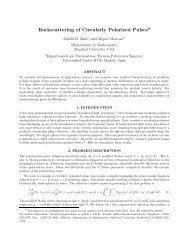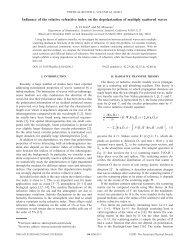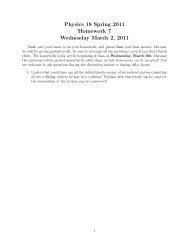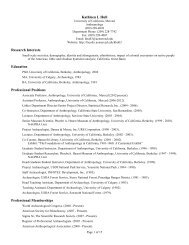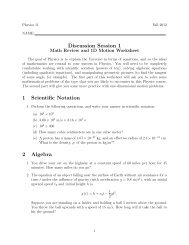You also want an ePaper? Increase the reach of your titles
YUMPU automatically turns print PDFs into web optimized ePapers that Google loves.
<strong>Physics</strong> 9 <strong>Fall</strong> <strong>2009</strong><br />
Homework 2 - Solutions<br />
1. Chapter 27 - Exercise 5.<br />
An electric dipole is formed from ±1.0 nC charges spread 2.0 mm apart. The dipole<br />
is at the origin, oriented along the y−axis. What is the electric field at the points (a)<br />
(x, y) = (10 cm, 0 cm) and (b) (x, y) = (0 cm, 10 cm)?<br />
————————————————————————————————————<br />
Solution<br />
(a) The dipole is oriented along the y−axis, and so the point (x, y) = (10, 0) is<br />
perpendicular to the dipole, for which the electric field is given by<br />
Edip = − 1<br />
4πɛ0<br />
p<br />
,<br />
r3 where p = qs is the dipole moment. Plugging in the numbers gives<br />
Edip = − 1<br />
4πɛ0<br />
p<br />
r3 = − 9 × 10 9 10−9 × 0.002<br />
0.13 = −18 N/C.<br />
(b) Now the point (x, y) = (0, 10) is along the axis of the dipole, with an electric field<br />
Edip = 1<br />
4πɛ0<br />
The only difference between this expression and our answer to part (a) is factor<br />
of −2. Thus, we can immediately write down the electric field as Edip = 36 N/C.<br />
1<br />
2p<br />
.<br />
r3
2. Chapter 27 - Exercise 7.<br />
The electric field strength 5.0 cm from a very long charged wire is 2000 N/C. What is<br />
the electric field strength 10.0 cm from the wire?<br />
————————————————————————————————————<br />
Solution<br />
Recall that the electric field of a very long wire is<br />
E = λ<br />
2πɛ0r ,<br />
which falls off linearly with distance. This means that if we go twice as far away from<br />
the wire, then the field is half as strong. See that, as r → 2r, and if the field starts at<br />
E0 = λ/2πɛ0, then<br />
E →<br />
λ 1 λ 1<br />
= =<br />
2πɛ0 (2r) 2 2πɛ0r 2 E0.<br />
So, if the electric field is 2000 N/C at 5.0 cm, then at 10 cm, then the electric field<br />
must be 2000/2 = 1000 N/C. Thus, E (10 cm) = 1000 N/C.<br />
2
3. Chapter 27 - Exercise 20.<br />
A 0.10 g plastic bead is charged by the addition of 1.0 × 10 10 excess electrons. What<br />
electric field E (strength and direction) will cause the bead to hang suspended in the<br />
air?<br />
————————————————————————————————————<br />
Solution<br />
The bead carries a charge Q = 10 10 (−1.602 × 10 −19 ) = −1.602 × 10 −9 C, due to the<br />
excess electrons. We want to support this bead in space, against the pull of gravity.<br />
Gravity pulls the bead down, and so the electric force must push the bead up. Since<br />
the bead is negatively charged, in order for the force to point up, the electric field must<br />
point down. So, to balance the forces we need QE = mg, and so E = mg<br />
. Plugging in<br />
Q<br />
the values gives<br />
E = mg<br />
Q = 10−3 × 9.8<br />
−1.602 × 10 −9 = −6.1 × 105 N/C.<br />
Expressed as a vector, E = −6.1 × 10 5ˆj N/C.<br />
3
4. Chapter 27 - Problem 34.<br />
Derive Equation 27.12 for the field Edipole in the plane that bisects an electric dipole.<br />
————————————————————————————————————<br />
Solution<br />
Equation 27.12 in the text gives the result as<br />
Edip = − 1<br />
4πɛ0<br />
p<br />
,<br />
r3 where r is the distance from the center of the<br />
dipole. Let’s start by looking at the picture to the<br />
right. The electric field from the positive charge<br />
points down and to the right, while that from the<br />
negative charge points down and to the left. The<br />
net field points straight down.<br />
The magnitude of the net field is E = −2Epos sin θ, where Epos is the field from a<br />
single charge, and the factor of 2 comes from the contributions of the two charges.<br />
The sine factor comes from the vertical components of the fields, while the horizontal<br />
components cancel. Now,<br />
Epos = 1 q<br />
4πɛ0 r2 2 ,<br />
+ (s/2)<br />
while sin θ =<br />
s/2 √<br />
r2 2<br />
+(s/2) . So, adding in the unit vector, ˆj, we have<br />
E = −2 1<br />
4πɛ0<br />
q<br />
r 2 + (s/2) 2<br />
s/2<br />
<br />
r 2 + (s/2) 2<br />
ˆj = − 1<br />
4πɛ0<br />
qsˆj<br />
<br />
r2 23/2 .<br />
+ (s/2)<br />
But, the dipole moment p = qsˆj Finally, for distances r ≫ s/2, then r 2 + (s/2) 2 ≈ r 2 .<br />
So, we find<br />
which is precisely Eq. 27.12.<br />
E = − 1<br />
4<br />
4πɛ0<br />
p<br />
,<br />
r3
5. Chapter 27 - Problem 45.<br />
(a) Show that the maximum electric field strength on the axis of a ring of charge<br />
occurs at z = R/ √ 2.<br />
(b) What is the electric field strength at this point?<br />
————————————————————————————————————<br />
Solution<br />
(a) The electric field along the axis of a ring of charge Q is given by E (z) =<br />
1 zQ<br />
4πɛ0 (z2 +R2 ) 3/2 , where z is the distance along the axis, and R is the radius of the<br />
ring. So, the field depends on z. It has a maximum when dE<br />
dz<br />
derivative gives<br />
= 0. Taking the<br />
<br />
<br />
dE Q d<br />
=<br />
dz 4πɛ0 dz<br />
z<br />
= Q<br />
<br />
4πɛ0<br />
1 3<br />
− 3/2 2<br />
2z2 <br />
= 0<br />
(z 2 + R 2 ) 3/2<br />
(z 2 + R 2 )<br />
(z 2 + R 2 ) 5/2<br />
This is zero when the term inside the parenthesis vanishes. This gives z 2 + R 2 =<br />
3z 2 , or z = R √ 2 , as claimed.<br />
(b) When z = R √ 2 , then<br />
E<br />
<br />
R√2<br />
= 1<br />
4πɛ0<br />
R/ √ 2 Q<br />
R/ √ =<br />
2 3/2<br />
2 + R2 1<br />
4πɛ0<br />
RQ<br />
√ 2 (3R 2 /2) 3/2<br />
Thus, the maximum value of the electric field is E = 2<br />
5<br />
3 √ 1<br />
3 4πɛ0<br />
2<br />
=<br />
3 √ 1 Q<br />
3 4πɛ0 R2 Q<br />
R 2 .
6. Chapter 27 - Problem 54.<br />
A problem of practical interest is to make a beam<br />
of electrons turn a 90 ◦ corner. This can be done<br />
with the parallel-plate capacitor shown in the figure.<br />
An electron with kinetic energy 3.0 × 10 −17<br />
J enters through a small hole in the bottom plate<br />
of the capacitor.<br />
(a) Should the bottom plate be charged positive<br />
or negative relative to the top plate if<br />
you want the electron to turn to the right?<br />
Explain.<br />
(b) What strength electric field is needed if the<br />
electron is to emerge from an exit hole 1.0<br />
cm away from the entrance hole, traveling<br />
at right angles to its original direction?<br />
Hint: The difficulty of this problem depends<br />
on how you choose your coordinate<br />
system.<br />
(c) What minimum separation dmin must the<br />
capacitor plates have?<br />
————————————————————————————————————<br />
Solution<br />
Because the field between the plates is constant,<br />
this problem is exactly like a gravitational projectile<br />
problem, only with a different acceleration!<br />
So, for a given acceleration, we want to figure<br />
out what the electric field needs to be to give<br />
the electron a range of 1 cm. We can see the<br />
angles from the diagram to the right, orienting<br />
our coordinates as shown.<br />
(a) We want the bottom plate to attract the electron, and so it should be positively<br />
charged.<br />
(b) Recall the projectile equations<br />
x (t) = x0 + v0xt + 1<br />
2axt2 = v0xt<br />
x (t) = y0 + v0yt + 1<br />
2ayt2 = v0yt − 1<br />
2ayt2 ,<br />
where we have set x0 = y0 = 0, and note that ax = 0. Solving the first equation<br />
for time gives t = x/v0x, which, upon substituting into the second equation gives<br />
6
y (x) = v0y ay<br />
x − v0x 2v2 x<br />
0x<br />
2 . Now, when x hits its maximum range, R, then y = 0. So,<br />
y (R) = 0 = v0y<br />
v0x<br />
R − ay<br />
2v2 R<br />
0x<br />
2 ⇒ ay = 2v0xv0y<br />
R .<br />
This is our acceleration. The electric field needed to give this acceleration is<br />
E = F<br />
q<br />
= may<br />
q<br />
= 2mv0xv0y<br />
qR .<br />
Finally, note that v0x = v0 cos θ, while v0y = v0 sin θ, and so 2v0xv0y = 2v 2 0 sin θ cos θ =<br />
v2 0 sin 2θ. So, E = mv2 0<br />
qR<br />
is KE = 1<br />
2mv2 0, and so<br />
sin 2θ. Finally, recall that the kinetic energy of the electron<br />
E =<br />
2 (KE)<br />
qR<br />
sin 2θ.<br />
Now, we plug in the numbers. The launch angle is θ = 45 ◦ , and so<br />
E =<br />
2 (KE)<br />
qR<br />
sin 2θ =<br />
2 × 3.0 × 10 7<br />
1.602 × 10 −19 × 0.01 sin 90◦ ≈ 37, 500 N/C.<br />
(c) Now, we want the minimum separation. If the plates are too close, then the<br />
electron will collide with the top plate, and won’t continue on its full parabolic<br />
arc. The electron reaches its maximum height when x = R/2, i.e., at the halfway<br />
point. So, when x = R/2, then<br />
y (R/2) =<br />
= v0y<br />
=<br />
R − v0x 2<br />
1<br />
=<br />
v0y R ay<br />
− v0x 2 2v2 <br />
R 2<br />
0x 2<br />
2v2 2v0xv0y R 2<br />
0x R 2<br />
R v0y<br />
4 v0x<br />
R tan θ. 4<br />
This is the minimum height. Now, θ = 45 ◦ , and tan θ = 1, so hmin = R/4. Since<br />
R = 1 cm, then hmin = 2.5 mm.<br />
7
7. Chapter 27 - Problem 58.<br />
In a classical model of the hydrogen atom, the electron orbits the proton in a circular<br />
orbit of radius 0.053 nm. What is the orbital frequency? The proton is so much more<br />
massive than the electron that you can assume the proton is at rest.<br />
————————————————————————————————————<br />
Solution<br />
The electric force holds the electron to the proton. Since it’s moving in a circle, there<br />
is also a centripetal force. The two forces are equal in magnitude, keeping the circular<br />
orbit stable. So, Felec = 1 e<br />
4πɛ0<br />
2<br />
r2 = mv2<br />
r = Fcent. Now, we can write v = rω, where ω is<br />
the angular frequency. The ordinary frequency is f = ω/2π. Thus, we can solve for<br />
the frequency to find<br />
Thus, ω 2 = 1<br />
4πɛ0<br />
1<br />
4πɛ0<br />
e2 mv2<br />
=<br />
r2 r<br />
e 2<br />
mr 3 , or since ω = 2πf,<br />
Plugging in the numbers gives<br />
f = 1<br />
<br />
2π<br />
1 e<br />
4πɛ0<br />
2<br />
<br />
1<br />
=<br />
mr3 2π<br />
(9 × 109 )<br />
f = 1<br />
<br />
2π<br />
= m<br />
r (rω)2 = mrω 2 .<br />
1<br />
4πɛ0<br />
e2 .<br />
mr3 (1.602 × 10 −19 ) 2<br />
9.11 × 10 −31 (0.053 × 10 −9 ) = 6.65×1015 rev/sec.<br />
8
8. Chapter 27 - Problem 61.<br />
Show that an infinite line of charge with linear charge density λ exerts an attractive<br />
force on an electric dipole with magnitude F = 2λp/4πɛ0r 2 . Assume that r is much<br />
larger than the charge separation in the dipole.<br />
————————————————————————————————————<br />
Solution<br />
Suppose that we hold the dipole a distance<br />
r away, oriented such that the negative<br />
side of the dipole points towards the line<br />
of charge, while the positive charge points<br />
away. The electric field of an infinite line<br />
charge is given by E = λ , where d is<br />
2πɛ0d<br />
the distance away.<br />
Now, if the distance from the line to the center of the dipole is r, then the distance to<br />
the negative charge is r − s/2, while it’s r + s/2 to the positive charge. So, the net<br />
force is Fnet = −qEneg + qEpos, or<br />
λ<br />
F = λ −q + q<br />
2πɛ0(r−s/2)<br />
= − qλ<br />
<br />
1 1 − 2πɛ0 r−s/2 r+s/2<br />
<br />
r+s/2−r+s/2<br />
= − qλ<br />
2πɛ0<br />
= − qsλ<br />
2πɛ0<br />
2πɛ0(r+s/2)<br />
(r−s/2)(r+s/2)<br />
1<br />
r2−(s/2) 2 .<br />
Now, the dipole moment is defined as p = qs. Furthermore, for r ≫ s/2, then r 2 −<br />
(s/2) 2 ≈ r 2 , and so we find<br />
F ≈ − λp<br />
,<br />
2πɛ0r2 which is precisely what we wanted, recalling that the negative sign means that the<br />
force is attractive.<br />
9
9. Chapter 27 - Problem 73.<br />
A positron is an elementary particle identical to an electron except that its charge is<br />
+e. An electron and a positron can rotate about their center of mass as if they were a<br />
dumbbell connected by a massless rod. What is the orbital frequency for an electron<br />
and a positron 1.0 nm apart?<br />
————————————————————————————————————<br />
Solution<br />
This problem is very similar to the hydrogen problem that we did earlier, and we can<br />
solve it in the same way. However, this time the electron doesn’t go around the positron<br />
- both go around each other! So, the distance between the two particles is twice the<br />
orbital radius. So, the force between the charges is<br />
FE = 1 e<br />
4πɛ0<br />
2<br />
2 ,<br />
(2r)<br />
and since they are going around in a circle,<br />
Fcent = mv2<br />
r .<br />
Again, replacing v = rω = 2πrf, we find that<br />
which gives<br />
Fcent = FE ⇒ mv2<br />
r = mr (2πf)2 = 1<br />
f = 1<br />
<br />
2π<br />
e2 .<br />
16πɛ0mr3 4πɛ0<br />
e2 ,<br />
4r2 Now, r = 0.5 nm is half the distance between the positron and electron. So, we find<br />
f = 1<br />
<br />
(9 × 10<br />
2π<br />
9 ) × (1.602 × 10−19 ) 2<br />
4 (9.11 × 10 −31 ) (.5 × 10 −9 ) 3 = 1.13 × 1014 Hz.<br />
10
10. Chapter 27 - Problem 74.<br />
You have a summer intern position with a company that designs and builds nanomachines.<br />
An engineer with the company is designing a microscopic oscillator to help<br />
keep time, and you’ve been assigned to help him analyze the design. He wants to place<br />
a negative charge at the center of a very small, positively charged metal loop. His<br />
claim is that the negative charge will undergo simple harmonic motion at a frequency<br />
determined by the amount of charge on the loop.<br />
(a) Consider a negative charge near the center of a positively charged ring. Show<br />
that there is a restoring force on the charge if it moves along the z−axis but stays<br />
close to the center. That is, show there’s a force that tires to keep the charge at<br />
z = 0.<br />
(b) Show that for small oscillations, with amplitude ≪ R, a particle of mass m with<br />
charge −q undergoes simple harmonic motion with frequency<br />
f = 1<br />
<br />
qQ<br />
.<br />
2π 4πɛ0mR3 R and Q are the radius and charge of the ring.<br />
(c) Evaluate the oscillation frequency for an electron at the center of a 2.0 µmdiameter<br />
ring charged to 1.0 × 10 −13 C.<br />
————————————————————————————————————<br />
Solution<br />
(a) Recall that, along the axis the electric field of a ring of charge is<br />
Ez = 1<br />
4πɛ0<br />
The force on a negative charge is F = qE, or<br />
F = − 1<br />
4πɛ0<br />
Qz<br />
(z2 + R2 . 3/2<br />
)<br />
qQz<br />
(z2 + R2 . 3/2<br />
)<br />
When z < 0 (i.e., when the charge is to the right of the ring), the force is to the<br />
left. When z < 0, when the charge is on the left, then the force is positive, and<br />
to the right. So, there is always a restoring force.<br />
(b) Suppose that we always stay close to the ring, such that z ≪ R. In this case,<br />
z 2 + R 2 ≈ R 2 , and so the force becomes<br />
F = − 1<br />
4πɛ0<br />
qQz<br />
(z2 + R2 ≈ − 3/2<br />
)<br />
<br />
qQ<br />
4πɛ0R3 <br />
z.<br />
So, we have a force of the form F = −kz, where k is the term in parenthesis.<br />
So, the force is proportional to the distance. This is just Hooke’s law, and so the<br />
system behaves like a mass on a spring!<br />
11
The natural frequency of a spring with constant k is f = 1<br />
<br />
k , and so we find<br />
2π m<br />
f = 1<br />
<br />
k<br />
2π m<br />
<br />
1 qQ<br />
= .<br />
2π 4πɛ0mR3 (c) Now, we have an electron of mass me = 9.11 × 10 −31 kg, and charge q = e =<br />
1.602 × 10 −19 C, at the center of a ring of radius R = 10 −6 m, carrying a charge<br />
Q = 10−13 C. With these numbers,<br />
f = 1<br />
<br />
qQ 1<br />
=<br />
2π 4πɛ0mR3 2π<br />
(9 × 10 9 ) 1.602 × 10−31 × 10 −13<br />
9.11 × 10 −31 × 10 −6 = 2.0 × 1012 Hz.<br />
12




